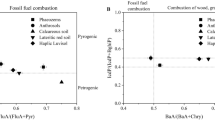Abstract
Site investigations require the collection and analysis of representative environmental samples to delineate impacts, risks, and remediation options. When environmental samples are collected, concentrations of semi-volatile polycyclic aromatic hydrocarbons (PAHs) begin to change due to several processes, such as evaporation, adsorption, precipitation, photo, and microbial degradation. Preservation techniques are used to minimize these changes between collection and analysis. The most common techniques are refrigeration, freezing, and acidification. In the mid 1970 s, regulatory agencies developed a holding time limit of 14 days for PAHs in soil/sediment samples stored at < 6 °C. The technical basis for this limit is not well defined yet failing to meet this limit may force resampling. This study examined the effectiveness of preservatives at maintaining PAH concentrations in sediment samples to 60 days. Sediment samples were collected at three sites that were impacted with petrogenic and pyrogenic PAHs. Chemically preserved (sodium azide, NaN3) and unpreserved samples were analyzed at defined time intervals from 0 to 60 days. Statistical analysis indicated acceptable preservation of PAHs in the sediment samples preserved with sodium azide for 60 days when maintained at either ambient laboratory temperature or 4 ± 2 °C, and for up to 21 days with no preservative when maintained at 4 ± 2 °C.

Similar content being viewed by others
References
ASTM (2013) Standard practice for estimation of holding time for water samples containing organic and inorganic constituents D4841-88 (Reapproved 2013). ASTM, Philadelphia
Birkholz DA, Roberts J, Hage A, Amyotte H, Cormier L, Lange C (2009) Sample hold time evaluation for polycyclic aromatic hydrocarbons in water samples. In: Water technology 2009 symposium, April 29–May 1, Banff, Alberta, Canada
Comba M, Young S, Zaruk D, D’SA I (1999) Stability of polycyclic hydrocarbons in fortified natural waters. In: The 42nd conference of the international association for Great Lakes Research, at Case Western Reserve University, Cleveland, OH, U.S., May 24–28, 1999
Douglas GS, Bence AE, Prince RC, McMillen SJ, Butler EL (1996) Environmental stability of selected petroleum hydrocarbon source and weathering ratios. Environ Sci Technol 30(7):2332–2339
Douglas GS, Emsbo-Mattingly SD, Stout SA, Uhler AD, McCarthy KJ (2015) Hydrocarbon fingerprinting methods. In: Murphy B, Morrison R (eds) Introduction to environmental forensics, 3rd edn. Elsevier, Burlington, pp 201–309
Douglas GS, Stout SA, Uhler AD, McCarthy KJ, Emsbo-Mattingly SD (2016) Advantages of quantitative chemical fingerprinting in oil spill identification and allocation of mixed hydrocarbon sediments. In: Stout SA, Wang Z (eds) Standard handbook oil of spill environmental forensics. Academic Press, London, pp 789–847
Emsbo-Mattingly SD, Litman E (2016) Polycyclic aromatic hydrocarbon homolog and isomer fingerprinting. In: Stout SA, Wang Z (eds) Standard handbook of oil spill environmental forensics. Academic Press, London, pp 255–310
Environment Canada (1996) Fraser river action plan: assessment of the integrity of chemicals in environmental samples over an extended period of time. Environment Canada, Vancouver, B.C., DOE FRAP-1996-27
Federal Register (1994) National oil and hazardous substances pollution contingency plan-final rule 40 CFR Parts 9 and 300
Federal Register (2012) Guidelines establishing test procedures for the analysis of pollutants under the clean water act., analysis and sampling procedures-final rule 40 CFR parts 136 and 260. Rules and regulations 29806–29809, vol 77, no 97
Field A (2009) Discovering statistics using SPSS, Chaps. 9 and 15. SAGE, London
Gallotta FDC, Lourenco RA, de Araujo LFM (2010) Evaluation of holding time for polycyclic aromatic hydrocarbon (PAH) analysis in saline water samples. Environ Forensics 11:309–314
Gustafsson O, Haghseta F, Chan C, Macfarlane J, Gschwend PM (1997) Quantification of the dilute sedimentary soot phase: implications for PAH speciation and bioavailability. Environ Sci Technol 31(1):203–209
Kochany J, Maguire RJ (1994) Abiotic transformations of polynuclear aromatic hydrocarbons and polynuclear aromatic nitrogen heterocycles in aquatic environments. Sci Total Environ 122:17–31
Leahy JG, Colwell RR (1990) Microbial degradation of hydrocarbons in the environment. Microbiol Rev 54(3):305–315
Mudroch A, Bourbonniere RA (1991) Sediment preservation, processing, and storage. In: Mudroch A, MacKnight SD (eds) CRC handbook of techniques for aquatic sediments sampling. CRC Press, Boca Raton, pp 131–170
Neff JM (1979) Polycyclic aromatic hydrocarbons in the aquatic environment—sources, fates and biological effects. Applied Science, London
NOAA (2014) Analytical quality assurance plan: Mississippi Canyon 252 (Deepwater Horizon) natural resource damage assessment. U.S. Department of Commerce, National Oceanic and Atmospheric Administration: Washington, DC
Parr J, Bollinger M, Callaway O, Carlberg K (1988) Preservation techniques for organic and inorganic compounds in water samples. In: Keith LH (ed) Principles of environmental sampling. American Chemical Society, Washington, pp 221–230
Riser-Roberts E (1998) Remediation of petroleum contaminated soils. Lewis, Boca Raton
Rost H, Loibner AP, Hasinger M, Braun R, Szolar OHJ (2002) Behavior of PAHs during cold storage of historically contaminated soil samples. Chemosphere 49:1239–1246
Stout SA, Emsbo-Mattingly SD, Douglas GS, Uhler AD, McCarthy KJ (2015) Beyond 16 priority pollutant PAHs: a review of PACs used in environmental forensic chemistry. Polycyclic Aromat Compd 35(2–4):285–315
USEPA (1996) Test methods for evaluating solid waste, physical/chemical methods—SW-846, 3rd edn. United States Environmental Protection Agency; Office of Solid Waste and Emergency Response. Washington, DC
USEPA (2001) Methods for the collection, storage and manipulation for chemical and toxicological analyses: technical manual. United States Environmental Protection Agency; EPA-823-B-01-002
USEPA (2005) Sample holding time re-evaluation. U.S. Environmental Protection Agency: Washington, DC, EPA/600/R-05/124
USEPA (2014) Test methods for evaluating solid waste, physical/chemical methods—SW846, update V, Chap. IV. United States Environmental Protection Agency, Washington, pp 1–21
Acknowledgements
This research was funded by the Chevron Energy Technology Company’s technology development funding. Sample collection, processing, and shipment of samples were performed by NewFields (Type 1) and Chevron and Arcadis (Type 2). Sediment PAH analysis was performed by Alpha Analytical Laboratory.
Author information
Authors and Affiliations
Corresponding author
Electronic supplementary material
Below is the link to the electronic supplementary material.
Rights and permissions
About this article
Cite this article
Douglas, G., Hardenstine, J., Rouhani, S. et al. Chemical Preservation of Semi-volatile Polycyclic Aromatic Hydrocarbon Compounds at Ambient Temperature: A Sediment Sample Holding Time Study. Arch Environ Contam Toxicol 75, 486–494 (2018). https://doi.org/10.1007/s00244-018-0517-y
Received:
Accepted:
Published:
Issue Date:
DOI: https://doi.org/10.1007/s00244-018-0517-y




